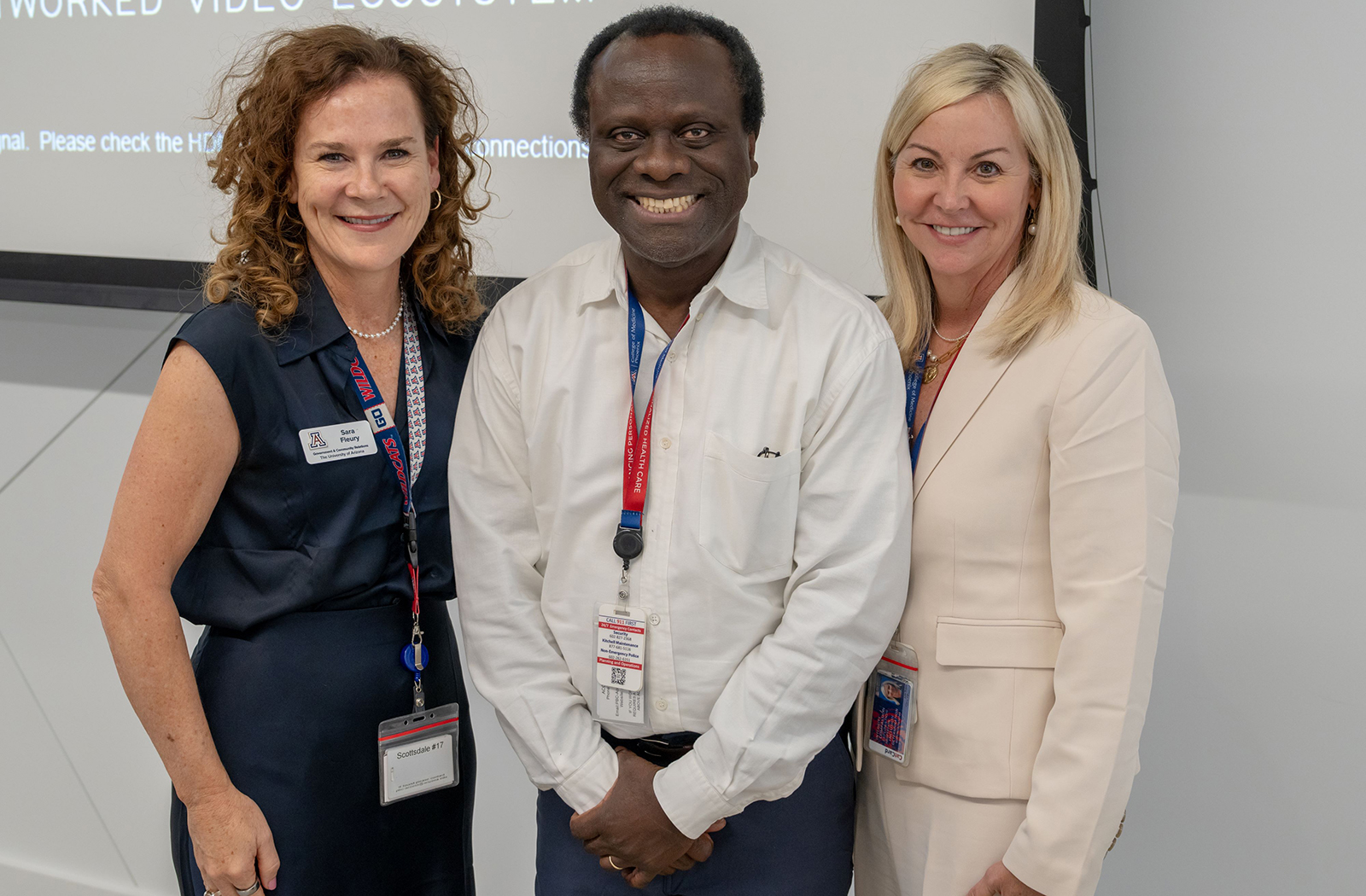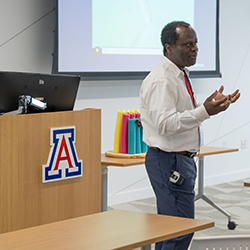
CATalyst Chat Focuses on the Fundamentals of Hearing Loss

A community outreach seminar series, the CATalyst Chat serves as a method of distributing the latest research from the University of Arizona’s faculty experts to general audiences.
Ebenezer Yamoah, MD, PhD, professor of Translational Neurosciences with the U of A College of Medicine – Phoenix, recently presented for the series. He is part of a team of investigators at the college who are interested in neurodegenerative disease and the sensory defects people can experience in life.
Held at the Bear Down Conference Center in Scottsdale, Arizona, Dr. Yamoah’s seminar educated attendees on the elements of hearing and the diminishing effects of hearing that come naturally with age.

The standard range of human hearing is typically between 30 Hertz (cycles per second) to 20,000 Hertz — the latter typically heard by young babies. According to Dr. Yamoah, the three most common causes of hearing loss are genetic, long-term exposure to loud noise and aging.
“About 30% of our population has hearing loss or some form of hearing deficit caused by genetic causes,” Dr. Yamoah said.
A distinguished research scientist, Dr. Yamoah’s laboratory has been innovating the scientific understanding of cellular and molecular mechanisms of inner ear sensory cells. To understand how hearing loss occurs, it is essential to understand the functions of the ear. Dr. Yamoah taught the room how each part of the ear works together to communicate sound.
The cochlea has three chambers with sensory hair cells residing in the middle chamber. These hair cells detect movement as small as a copper atom around their respective areas and each serve a different purpose for hearing.
“If you roll it out, the coiled (snail-shaped) cochlea, you find hair cells,” Dr. Yamoah explained. “There’s one row of remarkable hair cells called inner hair cells, whilst we have three rows of outer hair cells.”
Dr. Yamoah spoke about how the inner hair cells perceive the sound as it enters the ear while the outer hair cells act as amplifiers to enhance the sound sensitivity.
What his lab is trying to examine is how to mitigate progressive hearing loss by understanding the different activity responses based on the scale of hair cell displacement.
“By looking at it carefully, we could get a prediction as to what channel protein is indeed responding to sound frequency as it gets into the inner ear,” Dr. Yamoah said.
The idea: Perhaps the tip link — tiny thread-like structures in the inner ear — is the spring that exerts force onto the side of the stereocilia. Research suggests that positive ions enter the inner ear, activating other proteins at the base of hair cells, which then form synapses with the auditory neurons to send the sound to the brain.
Several theories on treating hearing loss have stemmed from restoring hair cells. One such method includes growing neurons and inner hair cells, and then reintroducing them into the inner ear.
“We could manipulate the neuron stem cells to take the phenotype of the auditory neurons and hair cells,” Dr. Yamoah said. “What we have done is that we took auditory neurons, put them in a dish surrounded by neural stem cells. We then attempted to determine whether they had formed functional connections.”
Near the end of the talk, Dr. Yamoah indicated that there is much work to be done regarding therapy strategies for restoring hearing. The seminar concluded with a Q&A with the audience in attendance.
Julie Bowe, the director of Development for the college, encourages philanthropic gifts toward the Dean’s Fund of Excellence to support incredible doctors like Dr. Yamoah.
Every donation makes a difference in the lives of the college's medical students, who represent the next generation of doctors for Arizona.
About the College
Founded in 2007, the University of Arizona College of Medicine – Phoenix inspires and trains exemplary physicians, scientists and leaders to advance its core missions in education, research, clinical care and service to communities across Arizona. The college’s strength lies in our collaborations and partnerships with clinical affiliates, community organizations and industry sponsors. With our primary affiliate, Banner Health, we are recognized as the premier academic medical center in Phoenix. As an anchor institution of the Phoenix Bioscience Core, the college is home to signature research programs in neurosciences, cardiopulmonary diseases, immunology, informatics and metabolism. These focus areas uniquely position us to drive biomedical research and bolster economic development in the region.
As an urban institution with strong roots in rural and tribal health, the college has graduated more than 1,000 physicians and matriculates 130 students each year. Greater than 60% of matriculating students are from Arizona and many continue training at our GME sponsored residency programs, ultimately pursuing local academic and community-based opportunities. While our traditional four-year program continues to thrive, we will launch our recently approved accelerated three-year medical student curriculum with exclusive focus on primary care. This program is designed to further enhance workforce retention needs across Arizona.
The college has embarked on our strategic plan for 2025 to 2030. Learn more.